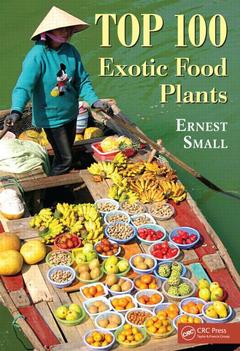Description
Top 100 Exotic Food Plants
Author: Small Ernest
Language: English
Subjects for Top 100 Exotic Food Plants:
Keywords
Acta Hortic; specialty; Indies; cookbooks; East Indies; key; Essential Oil; information; American Chemical Society; sources; Naya Prokash; culinary; Cab International; portrait; Catling; resources; Cape Gooseberries; south-east; Cab; asia; Acai Berry; Garden Huckleberry; Macadamia Nuts; Burnt Mill; Piper; International Plant Genetic Resources Institute; Palm Family; RAPD; Black Cumin; Cuminum Cyminum; Cumin; Above Ground; English Summary; Fair Trade; Rooibos Tea
Approximative price 232.80 €
In Print (Delivery period: 15 days).
Add to cartPublication date: 08-2011
Support: Print on demand
Publication date: 06-2017
· 17.8x25.4 cm · Paperback
Description
/li>Contents
/li>Readership
/li>Biography
/li>
Many edible plants considered exotic in the Western world are actually quite mainstream in other cultures. While some of these plants are only encountered in ethnic food markets or during travels to foreign lands, many are now finding their way onto supermarket shelves. Top 100 Exotic Food Plants provides comprehensive coverage of tropical and semitropical food plants, reviewing scientific and technological information as well as their culinary uses.
Wide-ranging in scope, this volume?s coverage includes plants that produce fruits, vegetables, spices, culinary herbs, nuts, and extracts. A user-friendly format enables readers to easily locate information on botanical and agricultural aspects, economic and social importance, food uses, storage, preparation, and potential toxicity. The book also contains an introductory chapter that reviews important historical, economic, geopolitical, health, environmental, and ethical considerations associated with exotic food plants. Thoroughly referenced with more than 2000 literature citations, this book is enhanced by more than 200 drawings, many chosen from historical art of extraordinary quality.
This timely volume also highlights previously obscure edible plants that have recently become prominent as a result of sensationalistic media reports stemming from their inherently entertaining or socially controversial natures. Some of these plants include the acai berry, kava, hemp, and opium poppy. A scholarly yet accessible presentation, the book is filled with numerous memorable, fascinating, and humorous facts, making it an entertaining and stimulating read that will appeal to a broad audience.
Introduction. Statistical Summary and Format of Presentation for the Exotic. Food Plants. Acai Berry. Acerola (Barbados Cherry). Akee. Allspice (Pimento). Arrowroot. Asafetida. Bamboo.Baobab. Bay. Betelnut. Breadfruit. Cacti. Candlenut. Cape Gooseberries and Tomatillo: Physalis Species. Caper. Carambola, Star Fruit. Carob. Cashew. Cassabanana. Ceriman. Chayote. Cherimoya and Atemoya. Chinese Artichoke. Citron. Clove. Coca. Coco De Mer (Double Coconut). Culantro. Cumin and Black Cumin. Cycads. Durian. Epazote. Feijoa. Fenu Greek. Galangal. Ginger. Ginkgo. Goji. Grass Pea. Guarana. Guava. Gum Arabic. Hemp (Hempseed). Horseradish Tree. Jackfruit. Japanese Vegetables. Jicama. Jujube. Kava. Khat. Kiwi. Kumquat. Lemongrass. Lemon Verbena. Loofah. Loquat. Lychee, Longan, and Rambutan. Macadamia Nut. Mangosteen. Medlar. Melons (Exotic). Miracle Fruit. Myrrh. Neem. Noni (Indian Mulberry). Nutmeg and Mace. Oca. Okra. Opium Poppy. Palmyra Palm. Passionfruit (Granadilla). Peach Palm. Pepino. Padilla. Persimmon. Pomegranate. Quinine. Rooibos Tea. Rose Apple. Roselle. Saffron. Sago Palm. Sapodilla. Sapote. Sarsaparilla. Sea Buckthorn. Spinach (Exotic Species). Stevia. Sweetsop and Soursop. Tamarind. Tobacco. Tree Tomato (Tamarillo). Turmeric. Vietnamese Herbs. Wasabi. Water Chestnut. WaxGourd. Wonderberry and Garden Huckleberry.Yard-Long Bean. Zedoary. Appendices. Index.
Dr. Ernest Small received a doctorate in plant evolution from the University of California at Los Angeles in 1969 and has since been employed with the Research Branch of Agriculture and Agri-Food Canada, where he presently holds the status of Principal Research Scientist. He is the author of over 300 scientific publications on plants and 13 books, several of which have received major awards. Dr. Small’s career has included dozens of appearances as an expert botanical witness in court cases, acting as an adviser to national governments, presenting numerous invited university and professional association lectures, supervising post-graduate students at various universities, participating in international societies and committees, journal editing, and media interviews.




